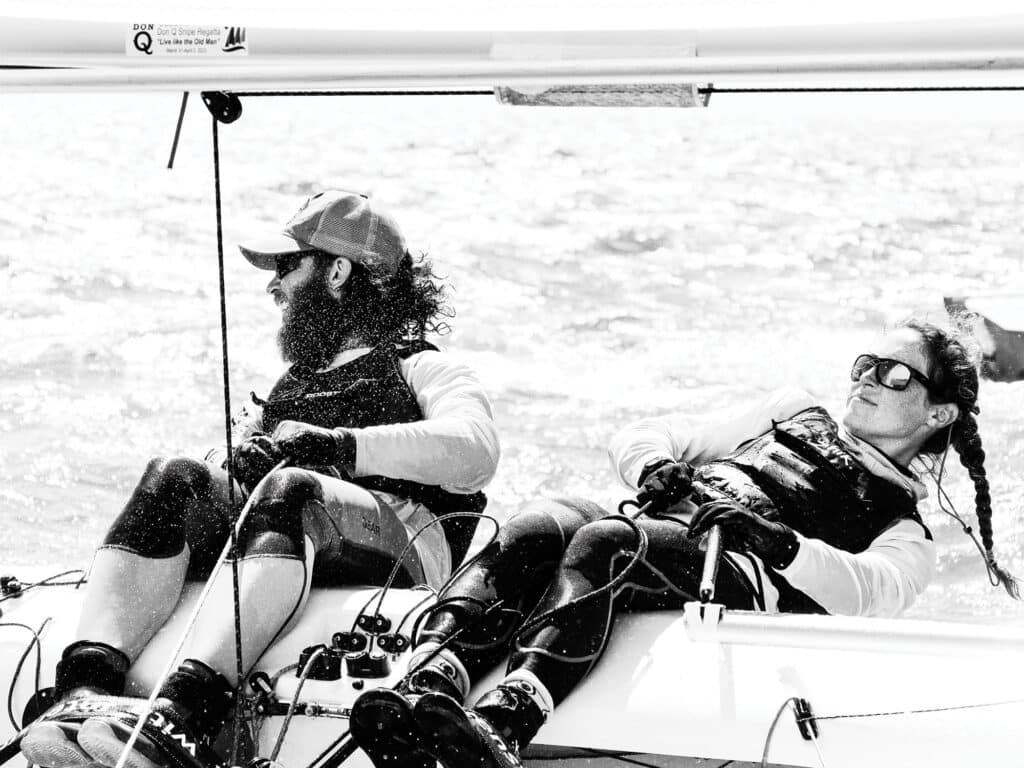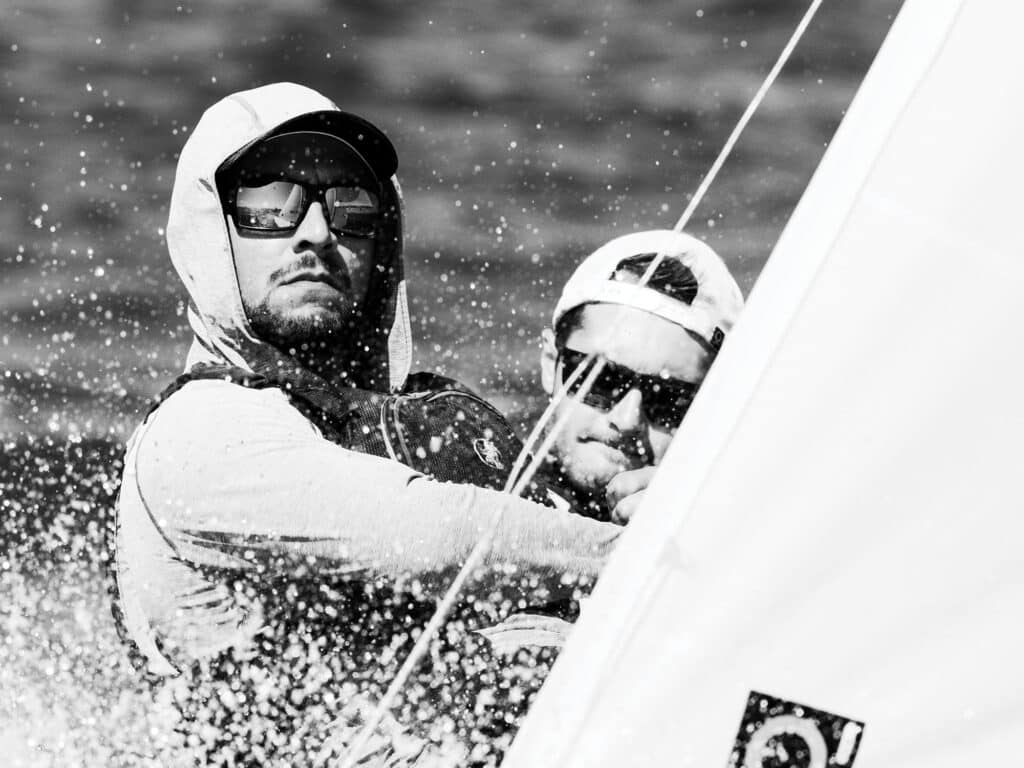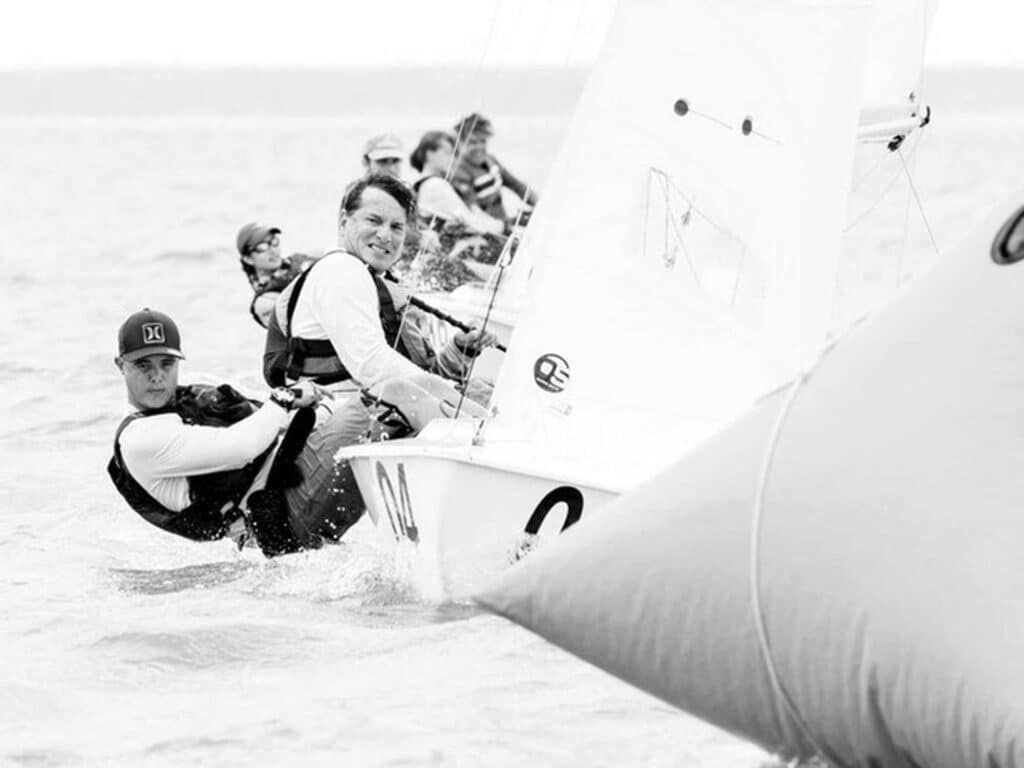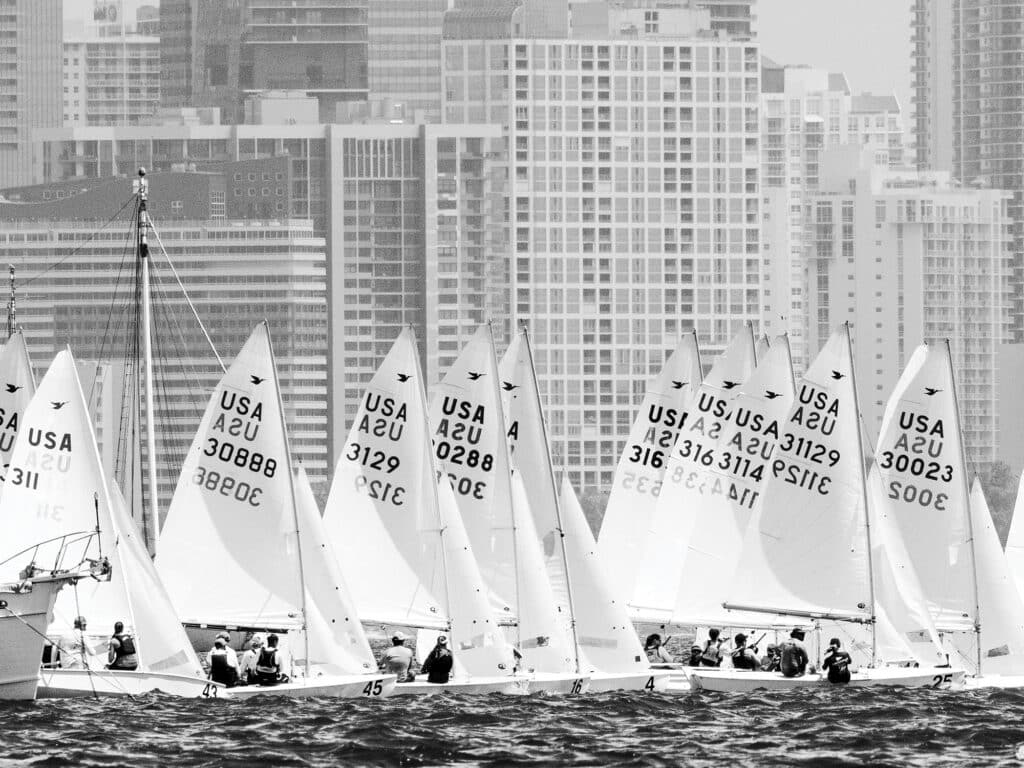
It’s early April on Miami’s Biscayne Bay, with an 18-knot easterly, gnarly chop and ribbons of sargassum seaweed—tough fare for racing any boat. We’re at the 2023 Don Q Snipe Regatta, heading uphill and racing against competitors with decades of experience in the class, as well as a slew of young hotshots and some first-timers—40 teams in all. It’s baptism by fire, my first real experience racing a Snipe. And like many who jump into the boat for the first time, I’m being served heaps of humble pie. About the only time my crew, Danielle Wiletsky, and I see the top of the fleet is when we cross paths on opposite legs of the course.
The upside is that we have a ringside seat to their techniques. At one point, we watch as the eventual regatta-winning team of Ernesto Rodriguez and Kathleen Tocke round the weather mark. He hands her the tiller extension and mainsheet, slides back to clear weeds off the rudder, then takes over again. Blink and we’ll miss it.
“It’s something we’ve practiced,” Rodriguez tells me afterward.
Then it’s back to the business of riding waves, Tocke at times with her face almost at the headstay when going down waves, then rapidly sliding aft as the ride nears its end. It’s the product of years of muscle memory, and Tocke and Rodriguez are clearly in sync. Tocke, who first sailed the Snipe in 2008, says they don’t talk much on their boat. “Occasionally, he’ll tell me to hike harder,” she adds, “not because I’m not, but more as encouragement.”
Soon they’re a speck on the horizon as we plod our way upwind to the mark.
We’re not alone at the humble-pie buffet. Here at the Don Q, scores of top-notch sailors, ex-collegiate and otherwise, come with high expectations only to leave with egos battered and bruised by class veterans, many old enough to be their parents. Rodriguez has been at this for more than two decades. Plus, he regularly trains with the likes of Hall of Famer Augie Diaz, who has been in the class for 56 years and won more Snipe championships than space allows here, and Peter Commette, 36 years in the class, a former Olympian, a Laser world champion, and keeper of his share of big-time Snipe titles as well. “They taught me a lot,” Rodriguez says. “I’m still part of that group, and we always go back and forth with information, sharing a lot about tuning and ways to best sail the boat.”
The Don Q was started by class icon Gonzalo Diaz in 1966 and named after its rum sponsor. It’s been held every year since, even during the pandemic. As boats set up at the host Coconut Grove Sailing Club, with the overflow at the US Sailing Center to the north, it’s impossible not to notice the number of 30-somethings—not only as crew, but also skippers.
At a gathering at a recent Snipe event, Augie Diaz asked, “How many here are under 30?” Over half raised their hands.

So, how is it that a 1931 design is still going strong? With its 380-pound hull, unstylishly high boom, and an off-wind setup requiring a whisker pole, it’s a quirky boat that doesn’t align with modern metrics for success. Cue the Snipe class promotional video and enter Gonzalo Diaz, affectionately known as “Old Man.” Born in 1930, his Snipe career began in Havana at age 15. He left Cuba in 1965, settled in Miami, joined the Coconut Grove Sailing Club, and began working his magic in the local Snipe fleet.
“He was the kind of fleet-builder who spent a lot of his private time helping people get into Snipes,” says his son, Augie. About 30 years ago, he started a rent-to-own program. “He’d get a boat and pretty much let a prospective owner say how much they wanted to rent the boat for. The rental fee went toward the boat’s purchase. If it took them five years to pay the boat off, that was fine with him. If it took 10 years, that was fine too.” Augie admits that it’s tough to tell just how many boats his father ran through this program, but he estimates it’s well over 30.
“It’s a great way to promote the boat,” says Alex Pline, of Annapolis, “because those renting boats have skin in the game. The longer they rent the boat, the more they have invested in it and the less likely they are to give that all up.”
There are rumors about a Miami-area warehouse full of an unsubstantiated number of Snipes—usually in the double digits—and it’s clear who the supplier is.
Pline’s fleet adopted a version of the Old Man’s program in 2021. His wife, Lisa, says: “I love stealing good ideas. We’re on our third boat and our fourth person, who just got busy with other stuff. But we were able to turn that boat over pretty quickly.”
Rodriguez, also from Cuba, was a Laser sailor who met Old Man shortly after arriving in the States. “He gave me a boat to use for free and helped me out in a bunch of ways, including getting me in regattas when I couldn’t afford it.”
Greg Saldana, another Old Man recruit, had never sailed a Snipe but showed enough interest to catch Diaz’s attention. “We met at the US Sailing Center when there were just trailers and a bunch of boats. Here comes this little guy in a van. He gets out, and he’s carrying a briefcase, pen and a piece of paper, ready for me to sign. I said, ‘Wait a minute. Before I sign, can we first go sailing?’ He really didn’t want to because it was really hot out, but we went. We didn’t even get out of the channel when he said, ‘You’re going to do fine. Let’s go back.’ And I signed.”

The list goes on, and although Old Man passed away in early March 2023, Augie carries on his father’s legacy. “He had a love for the class that was infectious. I don’t know how many people I’ve brought into the class,” he says, “but I’ll always be behind the number my father brought in. I keep trying to catch up to him. I don’t keep count. I’m just going to keep doing what’s good for the class.”
There are rumors about a Miami-area warehouse full of an unsubstantiated number of Snipes—usually in the double digits—and it’s clear who the supplier is. As my crew observed, “It seems almost every boat here was either owned by Augie or is being borrowed from him for this event.”
That includes us. We quickly get a taste of another component of the Snipe’s continued success as Pline comes over while we are setting up the boat. He helps us get the rig base settings correct, and Andrew Pimental, the US Snipe builder who is right next to us in the parking area, jumps in as well.
“Everyone’s always helping each other,” says Charlie Bess, who crewed with Enrique Quintero to take second in the Don Q. “It doesn’t matter if it’s someone’s first time in the class or someone who’s been around for decades. You can ask them anything.”
The assistance doesn’t end in the boat park. Just after the start of the first race, our hiking stick universal breaks, and as we are approaching the club dock, two people rush to see what had happened. It’s Saldana and his crew, Grace Fang. “We got out to the end of the channel and decided we didn’t want to deal with those conditions,” Fang tells us. They quickly offer up the tiller and hiking stick from their boat, and we make it out for the second race. With a no-throw-out series, it was a tough way to start a regatta, but the hospitality put it all into perspective.
Later that evening, I was about to deal with our universal repair when I find our original tiller and hiking stick back in our boat, repaired and ready for the next day, no doubt the work of Saldana and Fang. We discover later that Saldana was Old Man’s regular crew and close friend for many years. Saldana and Fang are not here just for the racing either.
“We couldn’t attend the memorial for Old Man,” Fang says, “but we thought just being here for this event would be a good way to honor him. I think there are others here for the same reason.”
On the water, top Snipe sailor Jato Ocariz serves as the fleet coach, coming alongside boats between races to offer advice. On the second day, with the wind now around 15 but still a strong chop, he has us sail upwind so he can check our setup. “Put two more turns on your shrouds and move your jib leads back,” he says. And just like that, we are able to point better and log our best finish, just about midfleet.
One of the class’s most successful endeavors is recruiting younger sailors. Bess is a self-confessed poster child for the effort. “When I was 15, Augie sent me an email, along with around 10 other juniors in our program. He got us a boat, provided coaching and helped us out. That’s how I got into the class,” Bess says. Now she’s the Miami Snipe fleet captain and on the class’s “next gen” committee, which focuses on attracting 30-somethings. “The idea behind it is that a lot of people do junior sailing, then college sailing, graduate and discover they have no place to go. We try to make the point that we are that next step.”

What is it about the Snipe that appeals to that demographic? For starters, there’s a practical component. Commette says: “Over the last 20 years, people have won Snipe world championships in boats that were 10 to 15 years old. I just sold a 1998 boat I wasn’t racing anymore. It’s one of the best boats I’ve ever sailed, and it could win a world championship easy. That’s the great thing about the Snipe. You can get an old boat and be competitive. You can get a used Jibe Tech or Persson for $5K, put some time into it, a couple of hundred dollars to update lines and things, and win a Worlds with it. That’s what makes it so fantastic for young kids.”
The boat is also a technical step up from junior and college sailing boats, but not so much that it’s intimidating. The spreaders can be adjusted to accommodate a range of crew weights, the mast can be moved fore and aft at deck level with a lever or block-and-tackle system, and there are the usual jib and main controls. Class veterans Carol Cronin and crew Kim Couranz are at the lighter end of the weight spectrum, which, according to Diaz, is optimally around 315 to 320 pounds, making it well within reach for mixed-gender teams and smaller teams. “There are enough controls that you can customize the boat to how heavy you are and how tall you are,” Cronin says. “Like the Star, the bendy mast keeps the boat exciting to sail. It takes a little more technique, but it also means you can tune the mast to fit a wider variety of weights.” Despite a breezy first two days, Cronin and Couranz finish ninth overall.
Then there’s the class motto: “Serious sailing, serious fun.” That appeals to the younger crowd. “I’ve always thought it sounds a little cheesy,” Bess says, but it’s entirely accurate. Taylor Schuermann, who crews for Diaz, says: “There’s a tremendous amount of enthusiasm, now more than ever, from that group. We have a WhatsApp group, and on Monday and Tuesday people are already asking, ‘Who’s going out this weekend?’ People are chomping at the bit to practice, sail together, and really put in that effort. Then when you show up to a regatta, no matter how long you’ve been in the class, it feels like a family reunion.”
And like a reunion, there are always those moments when you remember who is absent. Fittingly, the regatta’s Saturday night Cuban dinner includes a celebration of Old Man’s life, with photos, videos and a lot of storytelling.
“It’s all about peer groups,” Lisa Pline says, “and keeping it fun and competitive.”
Carter Cameron got into the lease-to-own program in Annapolis, says Evan Hoffman, the current Snipe class secretary. “All of a sudden, he started inviting all of his friends and became sort of a lightning rod for the fleet. Now he’s in San Diego, working for Quantum, and he’s doing the same kind of thing there.”
There is a downside, however, to the youth recruiting scheme, Pline says. “Every time we bring a new kid into the class, I think, ‘Oh, great, another kid who’s going to kick my ass.’”
The class also hosts under-30 regattas. “We found that if you can get a younger person interested in a Snipe, they’ll get other people their own age interested as well,” Pline says. “The U30 events really help with that. The idea is that it’s a regatta for younger people—it’s the older generation, if you will, reaching out to younger sailors, loaning boats for the event, doing whatever we can to make it successful.”
Over the years, the Snipe has withstood a lot of competition from startup classes that have the mentality of keeping it simple and easy.
Over the years, the Snipe has withstood a lot of competition from startup classes that have the mentality of keeping it simple, easy, and all the things that would make it a Laser-like doublehanded boat. “But the problem is,” Commette says, “that’s a dumbed-down type of sailing. While the Laser has excelled for what it is, it doesn’t teach you how to do so many other things necessary to become a really good all-around sailor. With the Snipe, you learn so much more, which is why so many America’s Cup champions, so many Olympians, so many other world champions have had significant Snipe experience.”
“One of the things that’s always appealed to me,” Cronin says, “is that, if you look at Old Man and Augie, you realize, ‘I can keep doing this for a long time, if I stay fit and stay interested.’”
I can relate. As a late adopter to the Snipe myself—let’s just say a few years past my retirement—I now know firsthand from the Don Q that I’ve got a long way to go to get to the front of the Snipe fleet. Thankfully, I’m guided by Old Man’s legacy and the efforts of many others in the class. Keep at it, ask the right questions, and someday I might be within shouting distance of Rodriguez. I’m sure many of the new kids in the class hope for the same.









